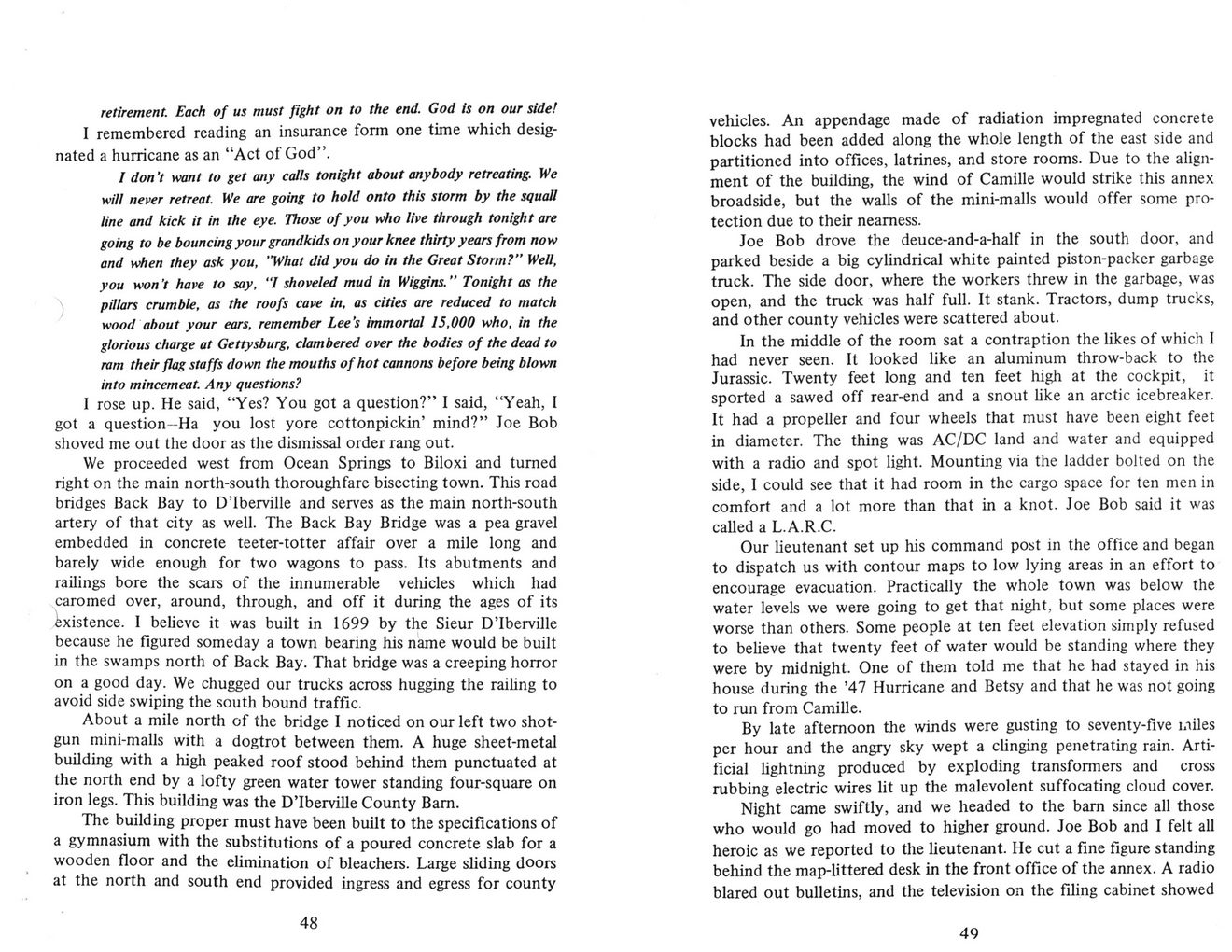This text was obtained via automated optical character recognition.
It has not been edited and may therefore contain several errors.
retirement. Each of us must fight on to the end. God is on our side! I remembered reading an insurance form one time which designated a hurricane as an “Act of God”. I don't want to get any calls tonight about anybody retreating. We will never retreat. We are going to hold onto this storm by the squall line and kick it in the eye. Those of you who live through tonight are going to be bouncing your grand kids on your knee thirty years from now and when they ask you, "What did you do in the Great Storm?” Well, you won’t have to say, "I shoveled mud in Wiggins." Tonight as the ^ pillars crumble, as the roofs cave in, as cities are reduced to match wood about your ears, remember Lee’s immortal 15,000 who, in the glorious charge at Gettysburg, clambered over the bodies of the dead to ram their flag staffs down the mouths of hot cannons before being blown into mincemeat. Any questions? I rose up. He said, “Yes? You got a question?” I said, “Yeah, I got a question—Ha you lost yore cottonpickin’ mind?” Joe Bob shoved me out the door as the dismissal order rang out. We proceeded west from Ocean Springs to Biloxi and turned right on the main north-south thoroughfare bisecting town. This road bridges Back Bay to D’lberville and serves as the main north-south artery of that city as well. The Back Bay Bridge was a pea gravel embedded in concrete teeter-totter affair over a mile long and barely wide enough for two wagons to pass. Its abutments and railings bore the scars of the innumerable vehicles which had caromed over, around, through, and off it during the ages of its Existence. I believe it was built in 1699 by the Sieur D’lberville because he figured someday a town bearing his name would be built in the swamps north of Back Bay. That bridge was a creeping horror on a good day. We chugged our trucks across hugging the railing to avoid side swiping the south bound traffic. About a mile north of the bridge I noticed on our left two shotgun mini-malls with a dogtrot between them. A huge sheet-metal building with a high peaked roof stood behind them punctuated at the north end by a lofty green water tower standing four-square on iron legs. This building was the D’lberville County Bam. The building proper must have been built to the specifications of a gymnasium with the substitutions of a poured concrete slab for a wooden floor and the elimination of bleachers. Large sliding doors at the north and south end provided ingress and egress for county 48 vehicles. An appendage made of radiation impregnated concrete blocks had been added along the whole length of the east side and partitioned into offices, latrines, and store rooms. Due to the alignment of the building, the wind of Camille would strike this annex broadside, but the walls of the mini-malls would offer some protection due to their nearness. Joe Bob drove the deuce-and-a-half in the south door, and parked beside a big cylindrical white painted piston-packer garbage truck. The side door, where the workers threw in the garbage, was open, and the truck was half full. It stank. Tractors, dump trucks, and other county vehicles were scattered about. In the middle of the room sat a contraption the likes of which I had never seen. It looked like an aluminum throw-back to the Jurassic. Twenty feet long and ten feet high at the cockpit, it sported a sawed off rear-end and a snout like an arctic icebreaker. It had a propeller and four wheels that must have been eight feet in diameter. The thing was AC/DC land and water and equipped with a radio and spot light. Mounting via the ladder bolted on the side, I could see that it had room in the cargo space for ten men in comfort and a lot more than that in a knot. Joe Bob said it was called a L.A.R.C. Our lieutenant set up his command post in the office and began to dispatch us with contour maps to low lying areas in an effort to encourage evacuation. Practically the whole town was below the water levels we were going to get that night, but some places were worse than others. Some people at ten feet elevation simply refused to believe that twenty feet of water would be standing where they were by midnight. One of them told me that he had stayed in his house during the ’47 Hurricane and Betsy and that he was not going to run from Camille. By late afternoon the winds were gusting to seventy-five miles per hour and the angry sky wept a clinging penetrating rain. Artificial lightning produced by exploding transformers and cross rubbing electric wires lit up the malevolent suffocating cloud cover. Night came swiftly, and we headed to the barn since all those who would go had moved to higher ground. Joe Bob and I felt all heroic as we reported to the lieutenant. He cut a fine figure standing behind the map-littered desk in the front office of the annex. A radio blared out bulletins, and the television on the filing cabinet showed 49

Coast General Wordcraft-Harekins-Charles-Sullivan1982-(06)